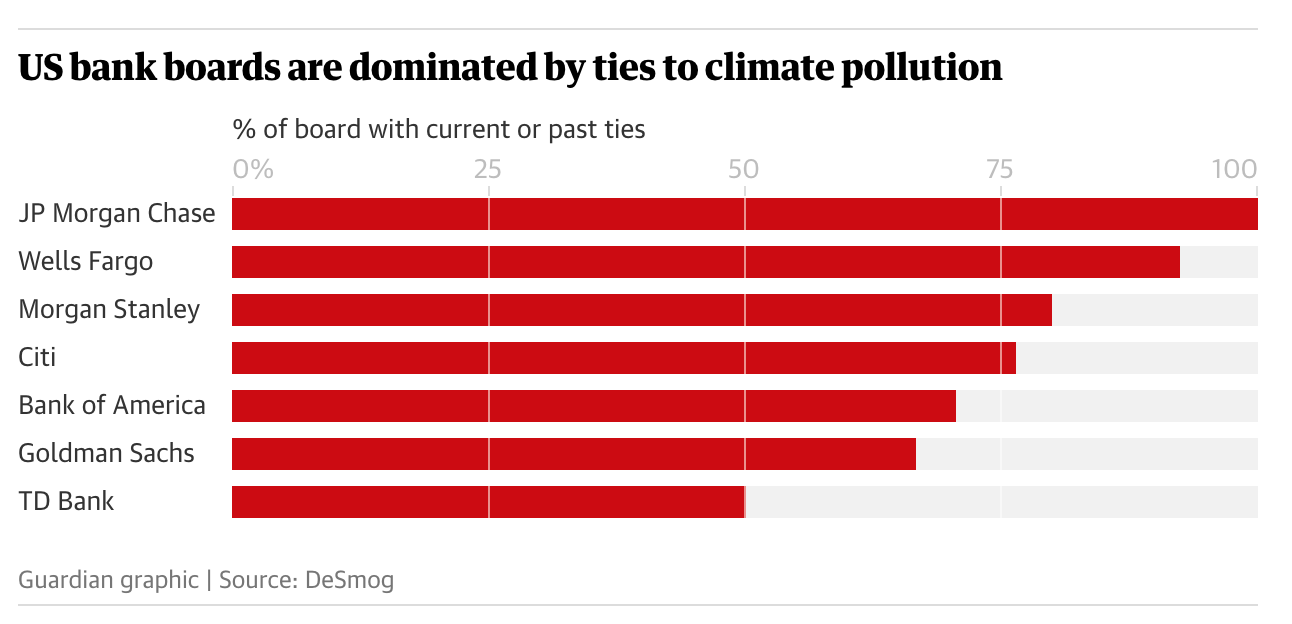Today’s newsletter is a collaboration with Emily Holden at Floodlight, a new non-profit news organization dedicated to investigating the corporate and ideological interests holding back climate action. ICYMI, we ran an interview with Holden about Floodlight’s launch last month.
Our article today investigates how decision-makers at major banks have conflicts of interest on climate, and what that means for the projects they back—like Line 3 in Northern Minnesota. It is also running in The Guardian.
At the top of today’s e-mail, you’ll also find a behind-the-scenes, podcast-style audio interview about this story. It starts with a discussion between Emily and I, and then ends with an interview with Giniw Collective founder Tara Houska, who’s been leading direct actions against the Line 3 pipeline.
I hope you enjoy this collaboration! Let me know what you think in the comments, and please consider supporting this 100 percent reader-funded, independent journalism with a subscription if you can.

By Emily Holden for Floodlight and Emily Atkin for Heated
U.S. banks are pledging to help fight the climate crisis alongside the Biden administration, but their boards are dominated by people with climate-related conflicts of interest, and they continue to invest deeply in fossil fuel projects.
Three out of every four board members at seven major US banks (77%) have current or past ties to 'climate-conflicted' companies or organizations—from oil and gas corporations to trade groups that lobby against reducing climate pollution, according to a first-of-its-kind review by climate influence analysts for the blog DeSmog.
One of the controversial projects those board members have chosen to back is the new Line 3 tar sands oil pipeline, currently under construction in northern Minnesota. If completed, the project would allow Canadian oil giant Enbridge to double the amount of high-polluting tar sands oil it currently transports through the region to 760,000 barrels per day.
Environmental groups estimate the new Line 3 would add 50 new coal plants’ worth of carbon emissions to the atmosphere every year for the next three to five decades. They say it is incompatible with the Biden administration’s climate and environmental goals, and they argue the project never should have been approved. They add that the Trump administration didn’t independently review the risks of building a tar sands pipeline underneath the headwaters of the Mississippi River, which flows all the way to the US Gulf Coast.
Neither Biden nor the banks funding Line 3 have acknowledged these concerns, and time is running out to halt construction. So in recent weeks, Indigenous water protectors in Minnesota have resorted to physically chaining themselves to Enbridge equipment, while activists across the country have been chaining themselves to the doors of the banks who finance the pipeline.
“There’s been a lot of complacency. People have been pursuing comfortable routes of advocacy,” said Tara Houska, whose group Giniw Collective has led several direct actions against Line 3. “I don’t think we’re going to get the answers we need comfortably.”
The financing behind Line 3
Enbridge has seven active loans relevant to Line 3, totaling $11.5bn, according to the Rainforest Action Network. In addition, banks have underwritten bonds to Enbridge totaling $5bn since the autumn of 2019, the group said.
From the U.S., Bank of America, Citigroup, JPMorgan Chase and Wells Fargo have made the project possible with billions of dollars in loans, although it’s impossible to tally precisely how much they have financed for the pipeline specifically. Another five large Canadian banks are also financing Enbridge, according to Ran.
Out of these nine North American banks backing Enbridge, six have recently published net-zero climate goals, pledging to align their investments with the international Paris climate agreement.
“The banks are gorging on doughnuts and then eating an apple afterwards,” said Richard Brooks, the Toronto-based climate finance director for Stand.earth. “We certainly can’t rely on banks or the private sector to lead us into climate safety and lead us toward emissions reductions. We need policy, we need regulation. We need government to act.”
DeSmog found Canadian banks have the highest percentage of directors with climate-conflicted ties: 82%. That figure was significant in the UK and elsewhere in Europe as well, at 78% and 61%, respectively.
The struggle to get banks to defund Line 3
In February, the group Stop the Money Pipeline began a campaign to demand that banks withdraw their financial support of Line 3.
But despite numerous direct actions across the country, the effort has not been nearly as successful as previous climate campaigns targeted at banks, like the campaign to end funding for drilling in the Arctic national wildlife refuge.
The progressive Minnesota congresswoman Ilhan Omar pointed to previous environmental victories and said activists must keep fighting. “We were able to stop the construction of the Keystone XL pipeline because activists collectively organized in large numbers to oppose it—we must use that same energy to stop this pipeline from causing irreversible damage,” she said.
Juli Kellner, an Enbridge spokesperson, argued Line 3 was a safety-driven project because it was replacing an older pipeline. She said it had received all its permits after a thorough review process.
“Shutting down existing pipelines does not erase demand. It merely forces the transport of essential energy by less efficient means such as ship, truck, and most notably rail,” Kellner said. “It is Enbridge’s responsibility to transport the energy people rely on daily by pipelines - the safest, most efficient means of transporting energy. It is also our responsibility to do what we can to address climate change. That is why we’ve set a target of net-zero emissions by 2050 and laid a credible path to achieving it, including tying compensation of our executives to our performance in this area.”

The most climate-conflicted banks: JPMorgan, Wells Fargo
Much of the U.S. economy is built on fossil fuels, and people with enough experience to be appointed to bank boards are likely to have some connection to climate-conflicted organizations. But the DeSmog analysts said the heavy representation of industry on boards shows a “lack of creativity” in recruitment and is probably why bank policies aren’t more environmentally progressive.
“Some of these banks have pledges, but it’s about ensuring that they see them through. We’re simply asking the question of: ‘With this person on the board, what’s the likelihood of them seeing them through?’” said Mat Hope, editor of DeSmog UK.
“When it comes to the consumer holding their bank card, we want to put the information out there that lets them know that these are the directors of the boards of the banks they’re banking with.”
DeSmog reviewed the careers of board directors and flagged any connections with high-polluting sectors, including fossil energy, agribusiness, steelmaking and mining. The group also relied on indexes that measure polluting companies, such as the Climate Action 100 list, which includes companies like Nestlé – which has contributed to deforestation. And they reviewed links to trade groups, lobbying firms and thinktanks that have opposed climate action.
JPMorgan Chase tops the list for directors with climate conflicts. All of its 10 directors have current or past ties to companies or organizations contributing to the climate crisis. Wells Fargo comes in second, with 12 out of 13 directors.

Most of the seven banks declined to comment or did not respond to requests for comment. Wells Fargo noted its net-zero commitment and its plans to disclose near-term climate targets, as well as its taskforce on climate-related financial disclosures.
All seven of the banks have potential climate conflicts among at least half the directors on their boards.
For example, Theodore Craver, a director at Wells Fargo, is also on the board of Duke Energy, a power company that owns significant coal and gas generation. Duke has vowed to reach net-zero carbon pollution by 2050, but environmental advocates have argued the company’s plan still includes a large amount of gas. Craver is also the retired CEO of Edison International, another energy company.
Michael Neal, who is on the board at JPMorgan Chase, was vice chairman of General Electric Company until his retirement in 2013.
Those kinds of connections could be significant obstacles to the Biden administration’s hopes that banks will commit to climate-friendly finance, activists warn.
Biden administration remains silent on Line 3 and banking conflicts
John Kerry, Biden’s climate envoy, wants banks to commit to more near-term goals, according to Politico. But the White House has also met with environmental and watchdog groups who want the administration to be more aggressive with banks.
The White House did not respond to requests to comment for this story.
Collin Rees, a campaigner for Oil Change International, said advocates have consistently heard there is a desire within the White House to move forward on climate finance regulation, to require banks to have capital requirements and pass stress tests, for example.
“That’s the way we would like to see it approached,” Rees said. “To talk about how we are regulating Wall Street. And to also talk about the fact that they are not only potential sources of clean energy investment, which is good, but also still driving the climate crisis.”
Last week, 145 organizations wrote Kerry a letter urging him to help end “the flow of private finance from Wall Street to the industries driving climate change around the world – fossil fuels and forest-risk commodities”. They asked Kerry to “recognize that Wall Street is not yet an ally”.
“As long as US firms continue to pour more money into the drivers of climate change, they are actively undermining President Biden’s climate goals,” they said.
In Alida, Minnesota, Jami Gaither, a resident, pointed to a wide trench in the ground that will hold the Line 3 pipeline as the real-world effect of what banks are supporting.
“This is obviously not just for one pipeline,” she said. “How much longer can we keep up this charade, this idea that we can keep going on developing fossil fuels? We’re building a fucking tar sands pipeline at the end of the world.”
Disclosure: DeSmog, the group that conducted the bank analysis, is supported by the Sunrise Project, which is also a contributor to Floodlight. Read more about Floodlight’s editorial independence policies here.
Catch of the Day:
Fish wants you to make sure to get some sun today. And drink water (not pictured).
OK, that’s all for today—thanks for reading HEATED! If you’d like to share this piece as a web page, click the button below.
To support independent climate journalism that holds the powerful accountable—and to receive HEATED’s reporting and analysis in your inbox four days a week—become a subscriber today.
If you’re a paid subscriber and would like to post a comment, click the “Leave a comment” button:
Stay hydrated, eat plants, break a sweat, and have a great day!











